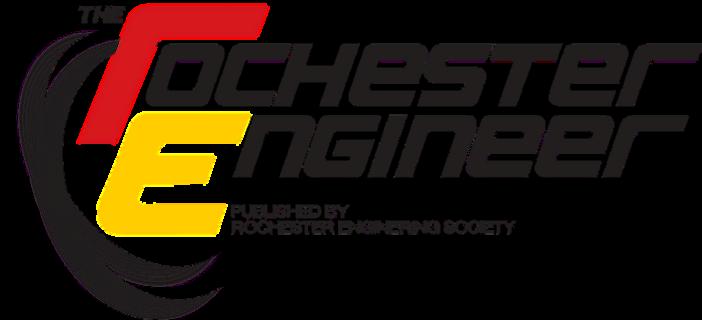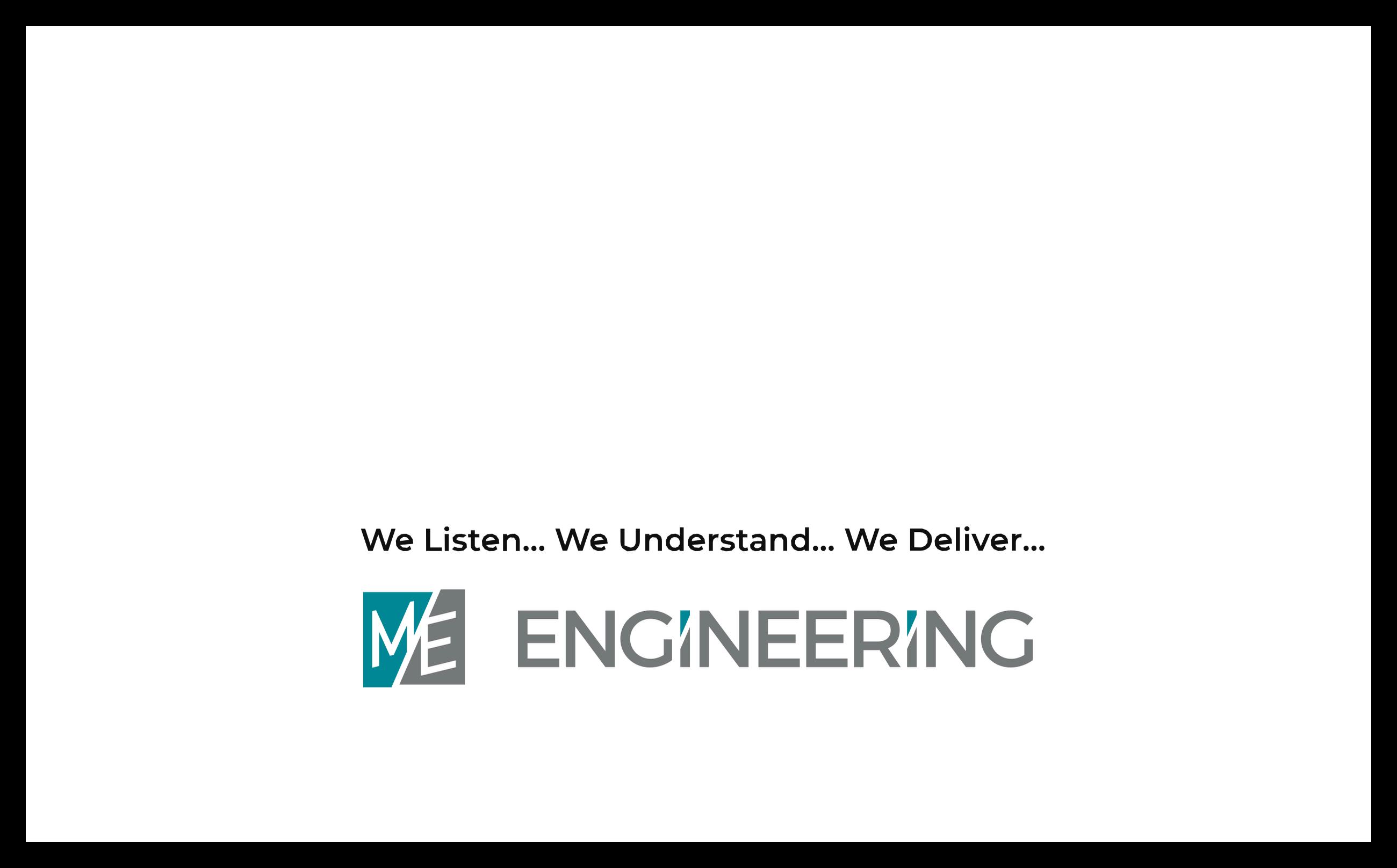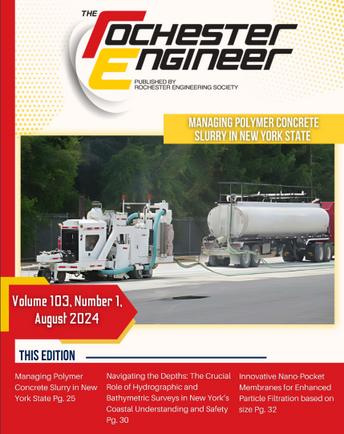



















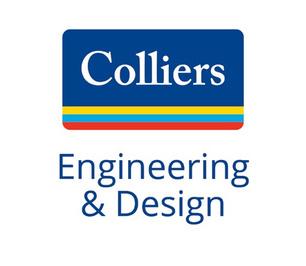



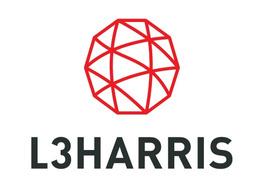





















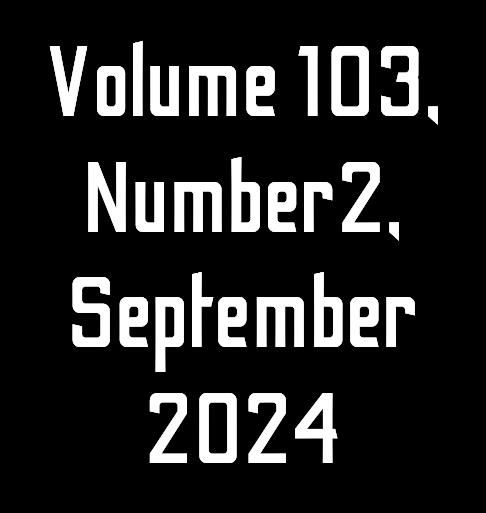
The RES will become the lead organization for improving the image and influence of the engineering community in the greater Rochester area by: Demonstrating a comprehensive knowledge of the region’s engineering and technical capabilities; Providing the best clerical support and public relations assistance to our affiliates; Continually communicating the engineering and technical accomplishments to both the engineering and technical community and the public; Providing regular forums and networking opportunities for the exchange of ideas and discussion of issues; and, Providing programs that identify career opportunities to the region’s youth and develop the skills of the practicing engineer.
The deadline is the 10th day of the month prior to the issue. Unless otherwise stated, opinions expressed in this publication are those of contributors, not of the Rochester Society, Inc.
Advertising information may be obtained by contacting the office of the Rochester Engineering Society or going to the website at www.roceng.org.
Published every month but July. You can purchase individual copies directly from ISSUU. 2,500+ Monthly Circulation (11 issues electronically) ISSN 0035-7405
Go to www.roceng.org to join the Rochester Engineering Society. Click on the individual membership and you can submit your application on-line.
News items and articles are invited. Materials should be submitted to e-mail: therochesterengineer@gmail.com www.roceng.org.
Stay up to date with the Rochester Engineering Society & their affiliates events by going to: https://roceng.org/Calendar

Campus



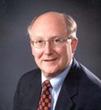


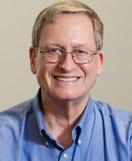
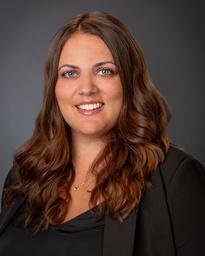
President
DENNIS ROOTE, PE
CDE Engineering & Environment, PLLC
dennis.roote@cde-pllc.com
Treasurer / Imm. Past President
MICHELLE SOMMERMAN, PE
Colliers Engineering
Michelle.Sommerman@collierseng.com
HOWARD RESSEL, PE
Popli Design Group (retired NYSATE) ressel@frontiernet.net
RICHARD E. RICE
Erdman Anthony rricesquash@gmail.com
BRETT ELIASZ, PE Colliers Engineering
Brett.Eliasz@collierseng.com
KENTON G. HINES
Merrill Lynch Kenton.Hines@ml.com
KELLY ROBINSON, PE, PHD
Founder, Electrostatic Answers kelly.robinson@electrostaticanswers.com
JESSIE COCQUYT
Administrative Director
res@frontiernet.net




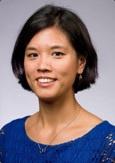
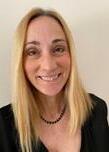

First Vice President
DAWN LaPIETRA
L3Harris Corporation
dawnlapietra@gmail.com
Second Vice President
MIKE KURDZIEL, PhD
L3Harris Corporation
mike.kurdziel@L3harris.com
STEVEN W. DAY, PhD Rochester Institute of Technology swdeme@rit.edu
NOAH KELLY
NAM Products Services Manager, Alstom noah.kelly@alstomgroup.com
JESSICA SHANG, PHD
Associate Professor, University of Rochester j.k.shang@rochester.edu
YVETTE LaBOMBARD, PE
Director Gas Engineering, RG&E
yvette labombard@rge.com
SHEILA RANSBOTTOM, PE
Senior Transportation Engineer, Wendel anumrich@wendelcompanies.com
It is indeed September!

As summer takes its curtain call this weekend, many of you will be sending children or grandchildren off to school. Some may have already returned from the annual pilgrimage to the college of your sons/daughters choice after partaking in that yearly ritual known as “move in day”. For almost all of us, Labor Day is a nice coda to summer punctuated with a much anticipated 3 day weekend. It is also the beginning of the program year, starting with clambakes, tours, trade shows, galas, continuing education, and networking opportunities These events will be numerous and spread throughout the year All of them require planning, commitment, and follow-up to ensure successful execution
This is where you, the engineer, the reader, come in
Becoming involved with any of the affiliates listed on page 39 gives a greater appreciation for your profession, a broader sense of your peers, and a deeper understanding what engineering means to you. Involvement in technical societies gives the benefit of exchanging the lessons you and your colleagues gained from your years of experience with yourselves and other younger engineers. I would be remiss if I did not mention that RES also provides ample opportunities to become involved through continuing education, community outreach, and networking. To find out more about RES, join us at our own monthly networking event - RES’s monthly Happy Hour at Rohrbach’s, 97 Railroad Street. Please join us there on September 5 at 5:00 for food, conversation, and beer – well, it IS a brewery!
Now, a few highlights in this month’s magazine:
·The RES Engineering Scholarship program announcement on page 12 details the application process – Please note the deadline for all materials is FRIDAY, DECEMBER 6, 2024. Similarly, the RES 2024 Engineer of the year, 2024 Young Engineer of the Year, and the 2024 Engineers of Distinction nominations process and deadlines are also posted on page 13.
·The University of Rochester and the Rochester Institute of Technology continue their paths of ground-breaking research as described in Campus News U of R on pages 14 through 17. U of R highlights this month include 2 articles about ongoing research: 1) nanotechnology hot spot detection to improve the lifespan and reliability of modern electronics; and 2) the removal of toxic protein wastes in aging brains, a problem that leads to Alzheimer's and Parkinson’s disease Campus News RIT (pages 18 through 21) details the award of a $3 million National Science Foundation Grant as “part of the NFS’s Research Traineeship Program” and highlights the accomplishments of Jolie Crunelle, recipient of the Norman Miles Award for Academic Excellence in Study Congratulations, Jolie!
·Finally, an inspiring story about Daniel Rodriguez, a Civil Engineer with Hunt Engineers who has been deaf since birth, and how he uses various techniques and existing software to navigate his duties and tasks during the workday Daniel’s story demonstrates that there are few bounds for those who want to pursue engineering and for those who recognize their talents and passions.
These are just a few highlights about the happenings in the Rochester Engineering community. For more information, please check out the RES website (https://www.roceng.org/) As always, if you see anything the magazine that interests you, or have any suggestions, please feel free to contact RES at res@frontiernet.net. Thanks again!
Dennis R. Roote, P.E. President, Rochester Engineering Society
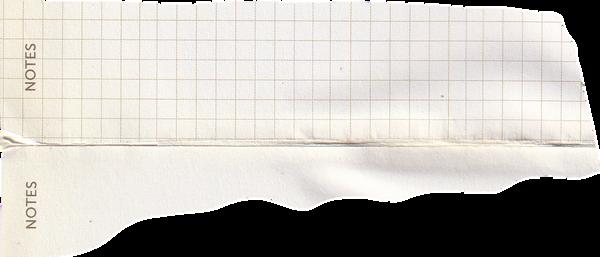




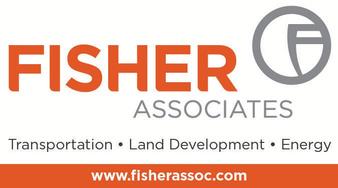
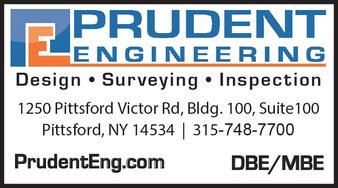
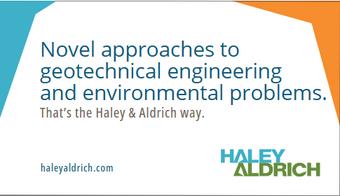

The article this month will be Electrical focused and speaks about routing non electrical piping, such as water piping, above electrical equipment.
The NEC is a minimum standard, and we must always take into consideration good design practices, local standards, manufacturers’ recommendations, and the clients’ specific design criteria. Nonetheless, strictly per the NEC, water lines can be installed above all electrical equipment except for the following: service equipment (added in NEC 2023) switchboards
switchgear (added in NEC 2014) panelboards
motor control centers
For these five listed categories, water lines can still run directly over the equipment if they are located above the dedicated electrical space as defined by NEC 110.26(E) and adequate protection has been provided against leaks, drips, and breaks.
NEC 110.26(E) states that the dedicated electrical space extends six feet above the footprint of the aforementioned equipment or to the structural ceiling, whichever is lower. Lay-in ceilings do not count as structural, and hard lids sometimes comply. If you are depending on a structural ceiling to cap the space, get confirmation from your structural engineer to avoid a standoff with the AHJ. Common drip protection includes drip pans as well as NEMA-3R or NEMA-2 enclosures, which are NEMA-1 with NEMA3R top/drip shields.
Strictly per NEC, water lines can run directly over data racks, for example, though this may contravene unenforced BICSI installation guidelines. Always remember to consider good design practices, especially where fire lines may pose risks to electrical and communications equipment, even if the presence of these lines is not a citable violation.
Reference Material: NEC 2023 110.26(E)
Feel free to provide any comments and follow-up questions to me at bpeters@cscos.com. Thank you for reading!
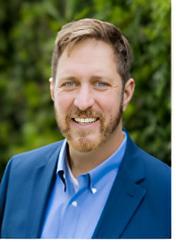
Bart Peters, PE, LEED AP Senior Project Engineer C&S Engineers,
Inc.

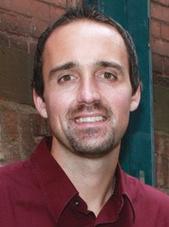
Brett Eliasz, P.E., LEED AP BD+C , RES Director

Hopefully this article finds you well and can be used as a reference for your project needs If anyone would like to contribute to the RES magazine and add an article or would like to request information on a specific topic (not limited to Electrical) just email me at Brett.Eliasz@collierseng.com. As always, any comments are appreciated…! Thank you for reading

ByLeeM.Loomis

Continuing with the historical sampling of the earlier writings on behalf of the Rochester Engineering Society, the years following "The Great War", into and through the “Great Depression”, continued to be a time of reaching out for the maturing Society, both locally and nationally The meeting minutes describe a series of technical discussions and presentations intended to broaden the technical horizons of the membership (especially the CE's, ME's and EE's). The RES affiliated itself with a number of National technical societies, adopted local Affiliated Societies, frequently held joint meetings with them and continued taking action on a growing list of public matters Certain issues of standardization, some crucial to public safety, became the responsibility of the RES and its affiliates. In the pervasive economic downturn of the “Great Depression”, the magazine offered classified advertising for unemployed engineers, technicians and draftsmen and took other steps to try to deal with the crisis Still, it continued its effort to shape the function, focus and infrastructure of the City of Rochester, and beyond World War, again affected the Society, taking away many of its leaders while providing opportunities for others to step forward to fill these vacancies. In an effort to provide even greater perspective on the happenings and concerns of the day, a synopsis, featuring selected items from "The Rochester Engineer" has become an integral part of this series The Second World War, the Korean Conflict, and the Vietnam War are now history. These experiences have changed the face of and will, no doubt, influence the future of the community. The Rochester municipal leadership and the industrial community have become immersed in the coldwar, growth economy
June 2, 1978 (Board Meeting, Chamber of Commerce) Editor’s Note: Minutes not found in RES Archives
September 20, 1978 (Board Meeting, University Club) The Board approved applications for two Regular and for one Junior Membership Membership Report: Regular (408), Associate (7), Junior (26), Student (9), Non-Resident (23), Sustaining (19), Emeritus (39) and Honorary (5) for a total of 536. Engineer of the Year Award: Chair Douglas Marshall recommended moving the solicitation of candidates up to November and the decision for Engineer of the Year up to mid-December to facilitate an earlier announcement and the featuring of the Award winner in the January issue of the magazine RES President Dick Rice announced that the October 11th luncheon meeting would feature Raymond Keefe, PE, Monroe County Commissioner of Physical Services, on the subject, “Airport Master Plan”. RES 2nd V.P. Lee Loomis moved that the revised Articles 1 & 3 on RES Membership be modified to add “Retired Member”, to allow for voting and with annual dues at $5. President Dick Rice moved that Article VII, Section 1, be amended to add the office of third vice president The Board vote was unanimous President Dick Rice, noting the Board vacancy due to the resignation, and departure, of RES Director James Row, called for nominations. In response, RES Junior Past President John Robertson nominated Dr. Brian Thompson, Dean of the U of R’s College of Engineering and Applied Science, and the Board vote was unanimous. President Dick Rice then pointed out that, with the RES Constitution ending the RES terms of office in May, and the holding of the RES Annual Meeting in June, the Society was technically without leadership for almost a month, each year.


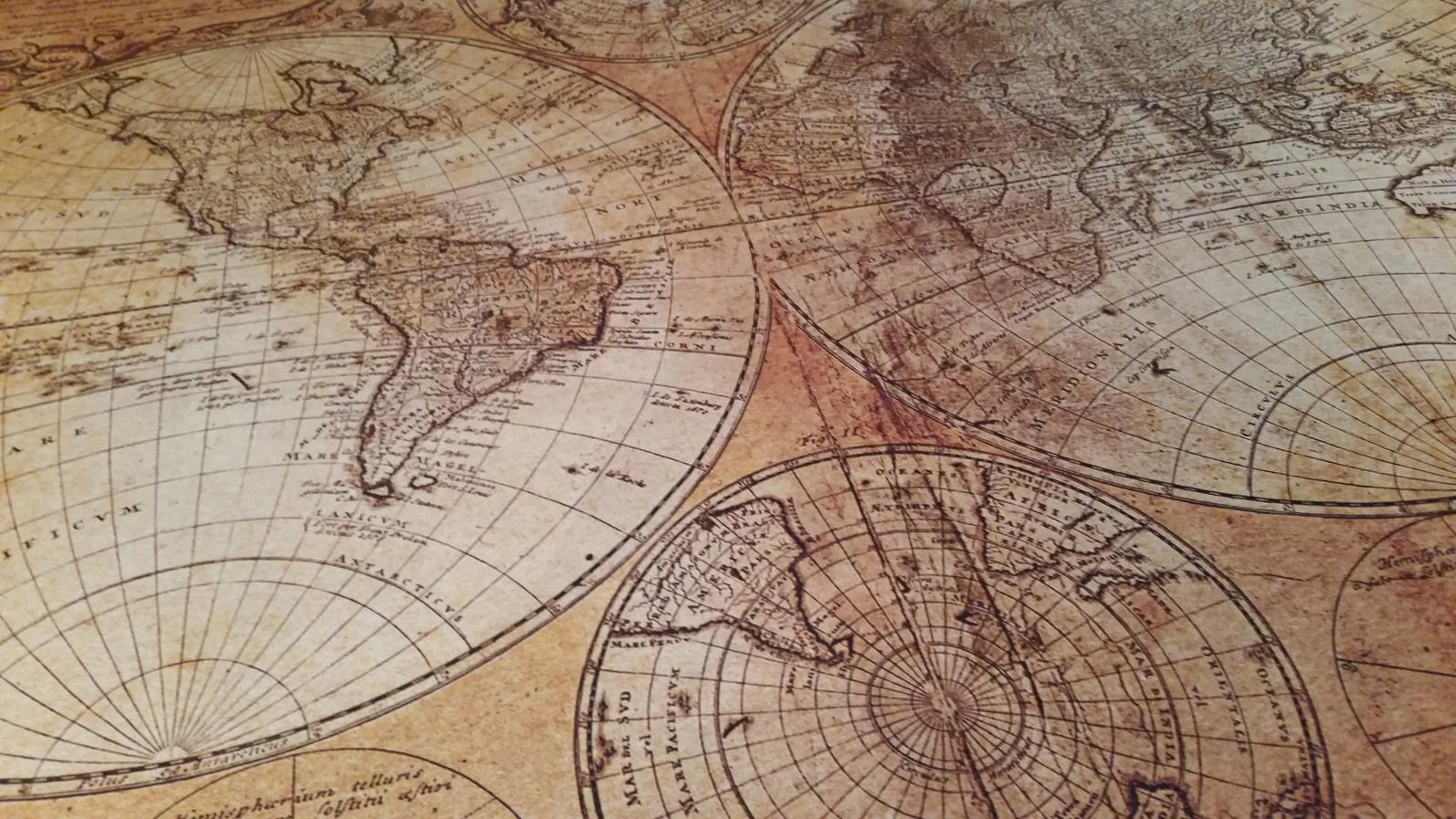


Therefore, President Dick Rice moved that, under Article VI, Section 1, the date for the RES Annual Meeting be, “moved to May of each year.” Editor’s Note: RES President Dick Rice noted that these several proposed changes in the RES Constitution would require a vote of the entire membership, at the next regularly scheduled RES Annual Meeting.
“The Rochester Engineer” (September 1978) Reprinted with permission from The Grantsmanship Center NEWS, an article by Howard Marlowe, President of Washington Non-Profit Services, “How to Affect Legislation Before it Affects You”, describes, in detail, the steps necessary for successful lobbying for Federal Grants, on behalf of Non-Profit Organizations The article covers the origins of legislation, introduction of bills, the role of committees, committee hearings, mark-up and reporting, getting a bill on/off the calendar, actions on the floor, conference committees, presidential approval, techniques for effective lobbying. It urges that proponents of legislation: be as precise as possible in presenting your case, be both specific and practical as possible, let the Congress Member know how your organization can be of help, do not threaten, be brief, leave behind a one-sheet summary of your case, follow up your visit, and know that “lobbyist” is a sensitive term Finally, proponents of new legislation should understand about giving testimony (oral or written), become acquainted with Congressional Aides, appear well-aware of the legislative process(es), and regularly consult the Congressional Record for updates on similar or competing legislation This issue also calls out Prof. Brian J. Thompson (recently elected to the RES Board), as the recipient of the Albert M Pezzuto Award, presented only once every five years, by the Society of Photo-Optical Instrumentation Engineers (SPIE), “In recognition of exceptional service to the Society.” Brian, a specialist in diffraction phenomena, holography, and image processing, had been the 1967 recipient of the Society’s President’s Award, was also a Fellow of the Optical Society of America, the Institute of Physics (UK), and a member of the American Physical Society, the American Association for the Advancement of Science, and the author of over 100 publications in scientific journals. Editor’s Note: Dr. Thompon, elected RES President in 1983, would be named “2011 RES Engineer of the Year” for his remarkable career, and his decades of dedicated service to the RES.
18,
Subsequent articles in this series will describe the RES' continuing outreach to other technical societies as it considered its role in this and the larger community. It will feature more of the activities of the RES as it moved to be of greater service to its membership, as the Society adopted a greater role in shaping the future of the City and its environs Noted also, will be the contributions made by RES members in the struggle to meet the challenges coming out of World War II, the Korean Conflict and the Vietnam War, as well as a hoped-for period of post-war growth and prosperity. These articles will also feature an impressive array of RES activities in support of post-war re-emergence of Rochester area industry, and the continuing prosperity of the second-half of the 20th Century.
We welcome your questions and comments on this series.





Recently, on several occasions, I have been asked if the RES would consider bringing its Tutoring Team to “XYZ Elementary School”.
With the closing of Dr. Walter Cooper Academy (RCSD School #10), our “Cooper Scholars” have recently been dispersed throughout the Rochester City School District, to schools of their parents’ choosing.
Since the Rochester Engineering Society’s Tutoring Team has completed its work at RCSD School #10, the RES Executive Board has decided that it should now be up to the Rochester City School District (RCSD) and its individual elementary school leaders to decide if they want to invite the RES to continue its work, and for them to suggest where that might happen.
With this recent closing of six Rochester City elementary schools (including #10 School), and the anticipated, temporary disruption within the faculties of the remaining twenty-five elementary schools, the RES is expecting that it may be a few months before things will be sorted out enough for elementary school principals and their teachers to know if they will want tutoring, what kind of tutoring they will want, and which of their students will need this type of attention.
At my recent, final meeting(s) with our RES Tutors, I found that many of them are interested in continuing their work with RCSD students, depending on their own (academic & personal) schedules.
The RES is receptive to discussions with any RCSD Leaders about returning to its tutoring work in Rochester City schools.
That said, it is RES’s strong preference to be asked to help recruit tutors from area universities and engineering consulting firms, to join existing, established tutoring teams, in the Rochester City School District
The RES is NOT interested in forming and managing another tutoring team.
The RES is now, as it has been for many years, firmly committed to helping the students of the RCSD achieve their full potential by assisting them as role models and as tutors.
Any contact to the RES on the issue of tutoring should now be made with the Society’s current President, Dennis Roote: Dennis Roote, PE (585) 330-6986 dennis.roote@cde-pllc.com 87 South Vendome Dr. Rochester, NY 14606-3829
Respectfully,
Lee M. Loomis
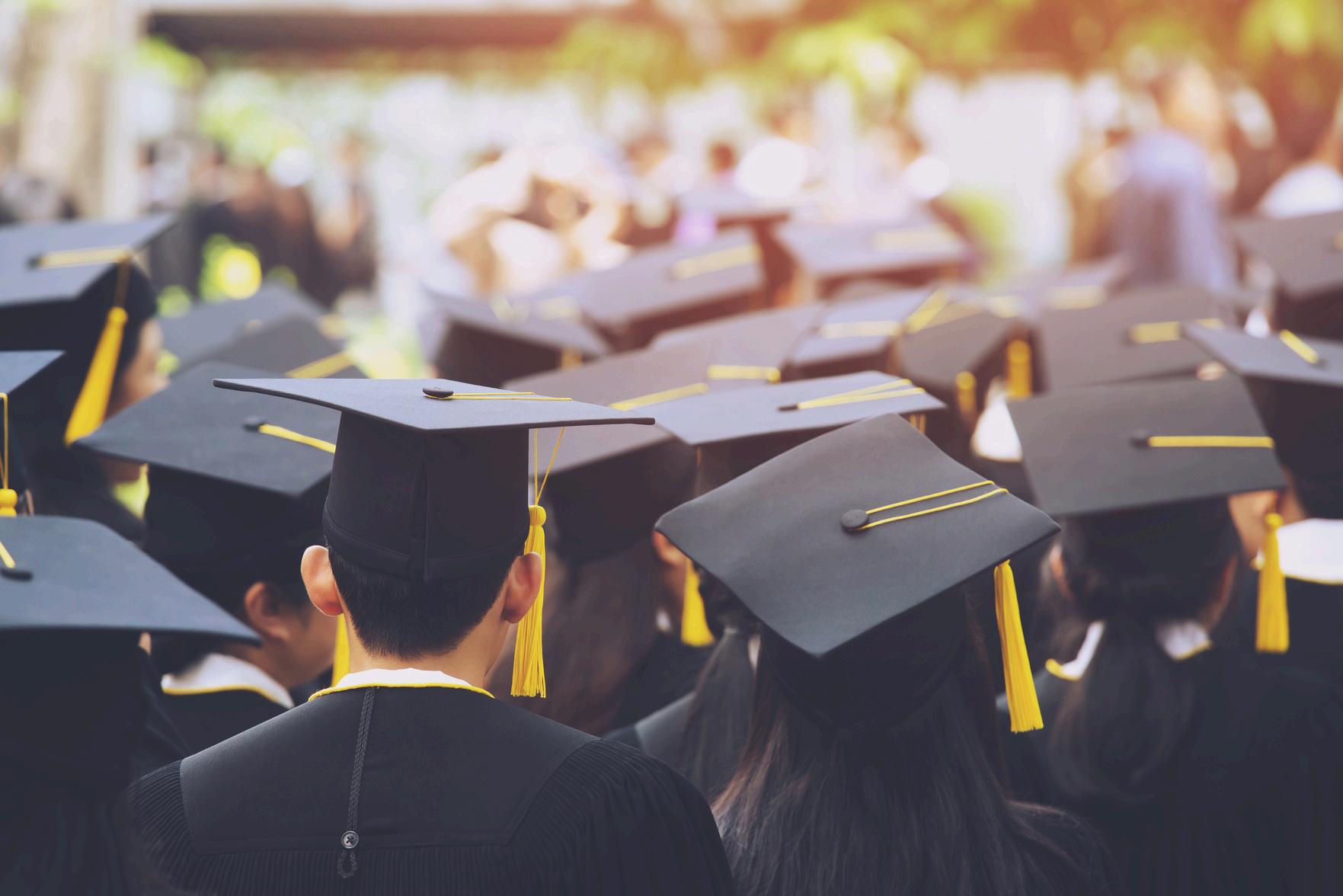
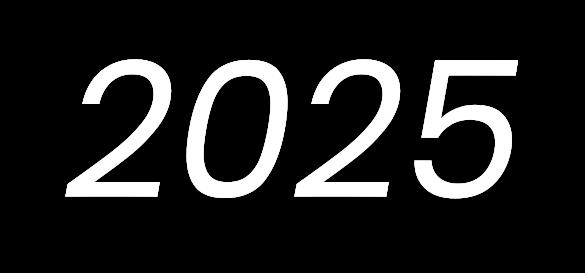
STEP1
STEP2
BEGINbygoingtotheRESWebsite ScholarshipPagetocheckthe eligibilityrequirements!
REQUESTaninterviewappointment bygoingtotheScholarship ApplicationPageandfillout eligibilityform.
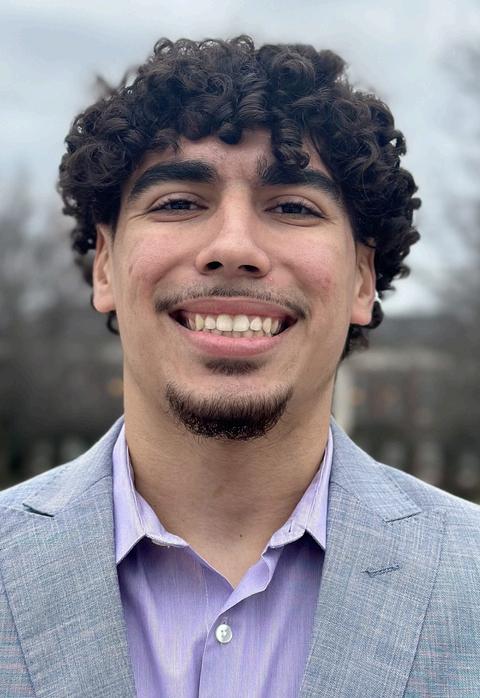
2024SusanL CostaMemorial Scholarship,GustavoRiveraSoto, UniversityofRochester, MechanicalEngineering
STEP3
GATHERtherequireddataand supportingmaterials.(detailson website)
OfficialTranscript
Applicant’sLetter
ReferenceLetter#1and#2
InterviewReport
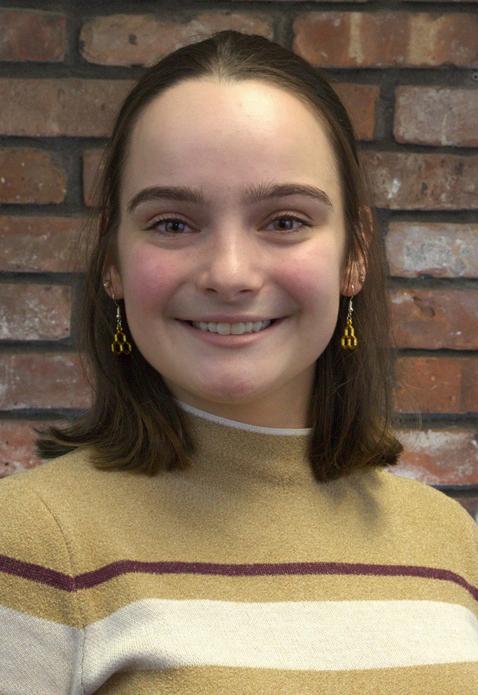
2024AdamW.LawasMemorial Scholarship,LaurenStoll, RochesterInstituteofTechnology, MechanicalEngineering


Kelly S. Robinson, PE, PhD, Owner
Electrostatic Answers, LLC
Click here to see past Engineer of the Year Award Winners
Past Engineers of the Year 15 years...(first awarded 1963)

2023 Young Engineer of the Year
Jessica Shang, PhD, Associate Professor, Dept of Mechanical Engineering, University of Rochester Scientist, Laboratory for Laser Energetics, University of Rochester
Mark Bocko, PhD, John W. Nieto, Richard Buckley, Susan, Houde-Walter, PhD, Donald P. Nims, PE, Martin E. Gordon, PE, Diane M. Trentini, Robert L. Clark, Jr., PhD, Lalit Mestha, PhD, Maureen S. Valentine, PE, Sergio Esteban, PE, Brian J. Thompson, PhD, , Gary W. Passero, PE, Kevin J. Parker, PhD, Satish G. Kandlikar, PhD
Past Young Engineers of the Year -15 years...
Joshua Rodems, PE, Andrew D. White, PhD, Daniel Rusnack, PE, Nick Vamivakas, PhD, Brett Eliasz, PE, Emily M. Smith, PE, Matthew T. Sidley, Danielle Benoit, PhD, John Papponetti, PE, Courtney E. Reich, PE, Clement Chung, PE, Sherwin Damdar, Michael J. Walker, EIT, Nathan Gnanasambandam, PhD, Venkatesh G. Rao, PhD
The RES Board of Directors introduced a streamlined nomination form. A simple initial form allows an individual or organization to nominate a candidate. The RES committee will then contact the nominator if the candidate progresses to the next phase. At that point, a final form will be used to gather essential details from the nominator and candidate which will be used to determine our award recipients.
The RES will select and recognize the 2024 Engineer of the Year, 2024 Young Engineer of the Year (and Finalists), and 2024 Engineers of Distinction Awards in a variety of public venues and media.
The Award recipients will be celebrated at an event to be announced in 2025. Visit our website at www.roceng.org and click on Engineering Awards, or call (585)586-8030 (res@frontiernet.net) to request a nomination form.
The following information is described: Eligibility for Nomination Awards Criteria
Deadline for Preliminary Nominations - Friday, October 4, 2024 Deadline for Final Nominations - Thursday, November 21, 2024

Luke Auburn July 17, 2024
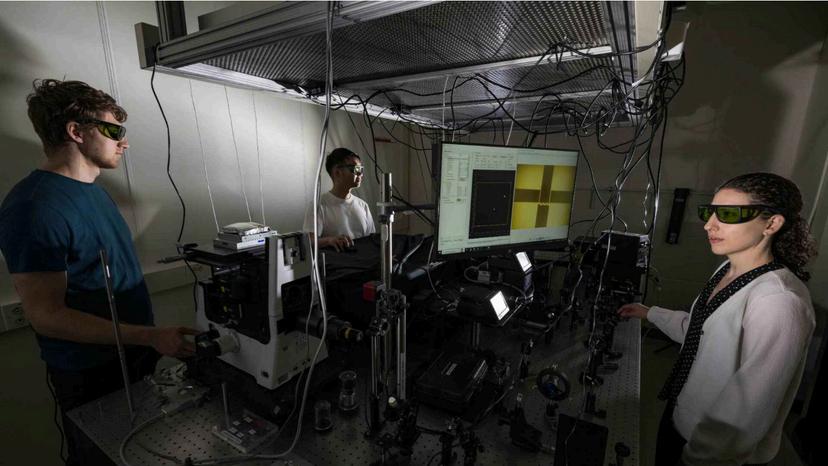
HEAT-SEEKING: Andrea Pickel (right), an assistant professor of mechanical engineering at the University of Rochester, and her materials science PhD students Benjamin Harrington (left) and Ziyang Ye have developed new techniques for mapping heat transfer in electronic devices using luminescent nanoparticles. (University of Rochester photo / J. Adam Fenster)
Borrowing methods from biological imaging, Rochester engineers have developed a way to spot tiny, overheated components that cause electronics’ performance to degrade.
Whenelectronicdeviceslikelaptopsorsmartphonesoverheat,theyarefundamentallysufferingfromananoscaleheat transferproblem.Pinpointingthesourceofthatproblemcanbeliketryingtofindaneedleinahaystack.
“Thebuildingblocksofourmodernelectronicsaretransistorswithnanoscalefeatures,sotounderstandwhichpartsof overheating,thefirststepistogetadetailedtemperaturemap,”saysAndreaPickel,anassistantprofessorfromthe UniversityofRochester’sDepartmentofMechanicalEngineeringandascientistwiththeLaboratoryforLaserEnergetics. “Butyouneedsomethingwithnanoscaleresolutiontodothat”
Existingopticalthermometrytechniquesareimpracticalbecausetheyhavefundamentallimitsonthespatialresolutionthey canachieve.SoPickelandhermaterialssciencePhDstudentsZiyangYeandBenjaminHarringtonengineeredanew approachtoovercometheselimitationsbyleveragingNobelPrizeinChemistry–winningopticalsuper-resolution fluorescencemicroscopytechniquesusedinbiologicalimaging.InanewScienceAdvancesstudy,theresearchersoutline theirprocessformappingheattransferusingluminescentnanoparticles.

Luke Auburn July 17, 2024
Byapplyinghighlydopedupconvertingnanoparticlesto thesurfaceofadevice,theresearcherswereableto achievesuper-highresolutionthermometryatthe nanoscalelevelfromupto10millimetersaway. AccordingtoPickel,thatdistanceisextremelyfarinthe worldofsuper-resolutionmicroscopyandthatthe biologicalimagingtechniquestheyusedforinspiration typicallyoperatelessthanonemillimeteraway.
Pickelsaysthatwhilethebiologicalimagingtechniques providegreatinspiration,applyingthemtoelectronics hadsignificanthurdlesbecausetheyinvolvesuch differentmaterials.
“Ourrequirementsareverydifferentfrombiologists becausethey’relookingatthingslikecellsandwaterbasedmaterials,”shesays.“Often,theymighthavea liquidlikewateroranoilbetweentheirobjectivelens andtheirsample.That’sgreatforbiologicalimaging,but ifyou’reworkingwithanelectronicdevice,that’sthelast thingyouwant.”
Thepaperdemonstratesthetechniqueusingan electricalheaterstructurethattheteamdesignedto producesharptemperaturegradients,butPickelsays theirmethodcanbeusedbymanufacturerstoimprove awidearrayofelectricalcomponents.Tofurther improvetheprocess,theteamhopestolowerthelaser powerusedandrefinethemethodsforapplyinglayers ofnanoparticlestothedevices
TheresearchwassupportedbytheNationalScience FoundationandaUniversityofRochesterFurthFund Award.
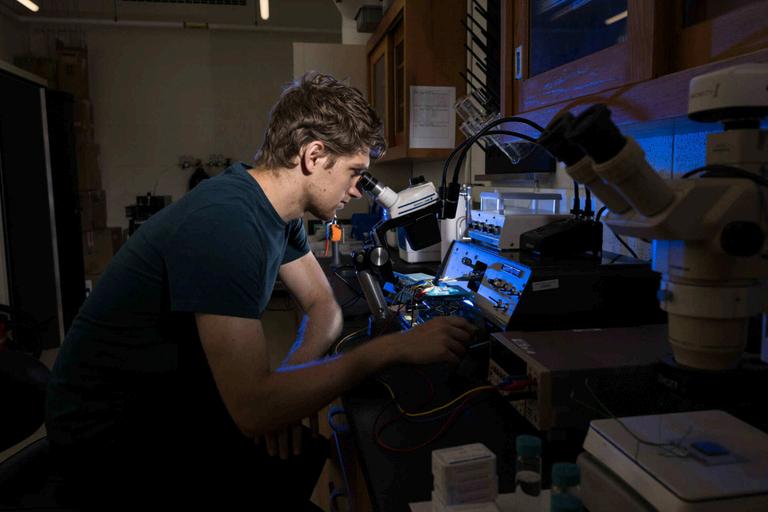
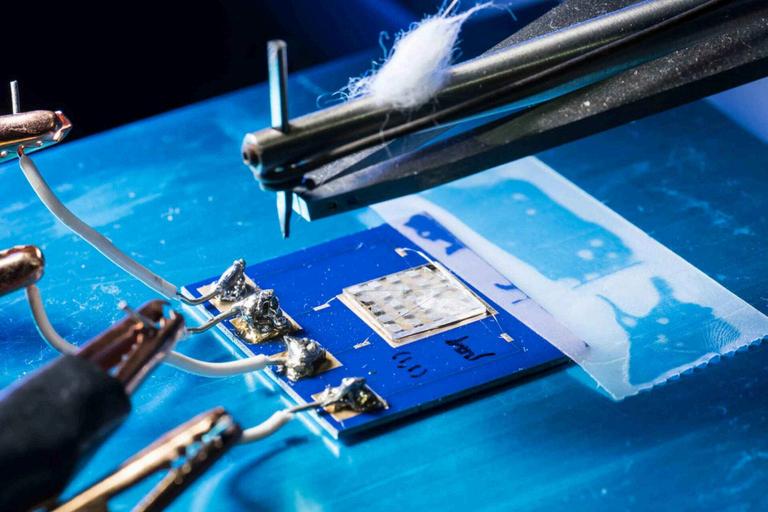

Mark Michaud August
15, 2024
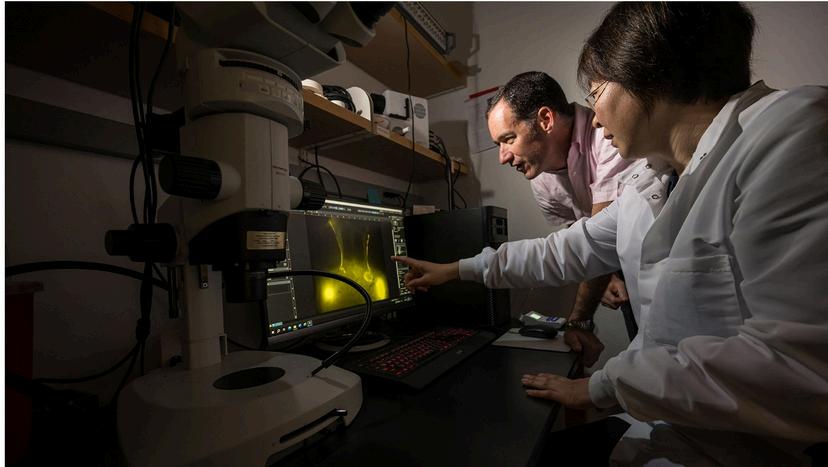
Rochester scientists are restoring the brain’s trash disposal system with a drug currently used to induce labor.
Alzheimer’s,Parkinson’s,andotherneurologicaldisorderscanbeseenas“dirtybrain”diseases,wherethebrainstrugglesto clearoutharmfulwaste.Agingisakeyriskfactorbecause,aswegrowolder,ourbrain’sabilitytoremovetoxicbuildupslows down.However,newresearchinmicedemonstratesthatit’spossibletoreverseage-relatedeffectsandrestorethebrain’s waste-clearingprocess.
“Thisresearchshowsthatrestoringcervicallymphvesselfunctioncansubstantiallyrescuetheslowerremovalofwastefromthe brainassociatedwithage,”saysDouglasKelley,aprofessorofmechanicalengineeringattheUniversityofRochester. “Moreover,thiswasaccomplishedwithadrugalreadybeingusedclinically,offeringapotentialtreatmentstrategy.”
Kelleyisoneoftheleadauthorsofthestudy,whichappearsinthejournalNatureAging,alongwithMaikenNedergaard, codirectortheUniversity’sCenterforTranslationalNeuromedicine.Thestudyisoneofmanycollaborationscarriedoutby researchersatRochester’sHajimSchoolofEngineering&AppliedSciencesandtheMedicalCenter
FirstdescribedbyNedergaardandhercolleaguesin2012,theglymphaticsystemisthebrain’suniquewasteremovalprocess thatusescerebrospinalfluid(CSF)towashawayexcessproteinsgeneratedbyenergy-hungryneuronsandothercellsinthe brainduringnormalactivity.Thediscoverypointedthewaytopotentialnewapproachestotreatdiseasescommonlyassociated withtheaccumulationofproteinwasteinthebrain,suchasAlzheimer’s(betaamyloidandtau)andParkinson’s(alphasynuclein).Inhealthyandyoungbrains,theglymphaticsystemdoesagoodjobofflushingawaythesetoxicproteins;however, asweage,thissystemslows,settingthestageforthesediseases.

Mark Michaud
August 15, 2024
Onceladenwithproteinwaste,CSFintheskullneedstomakeitswaytothelymphaticsystemand,ultimately,tothekidneys, whereitisprocessedalongwiththebody’sotherwaste Thenewresearchcombinesadvancedimagingandparticle-tracking techniquestodescribeforthefirsttimeindetailtheroutebywayofthecervicallymphvesselsintheneckthroughwhichhalfof dirtyCSFexitsthebrain.
InadditiontomeasuringtheflowofCSF,theresearcherteam includingstudyfirstauthorsTingDu,AdityaRaghunandan,and HumbertoMestre wereableobserveandrecordthepulsingoflymphvesselsintheneckthathelpsdrawCSFoutofthebrain “Unlikethecardiovascularsystem,whichhasonebigpump theheart fluidinthelymphaticsystemisinsteadtransportedbya networkoftinypumps,”saysKelley.Thesemicroscopicpumps,calledlymphangions,havevalvestopreventbackflowandare strungtogether,oneafteranother,toformlymphvessels.
Theresearchersfoundthatasthemiceaged,thefrequencyofcontractionsdecreased,andthevalvesfailed.Asaresult,the speedofdirtyCSFflowingoutofthebrainsofoldermicewas63percentslowercomparedtoyoungeranimals
TheteamthensetouttoseeiftheycouldrevivethelymphangionsandidentifiedadrugcalledprostaglandinF2α,ahormonelikecompoundcommonlyusedmedicallytoinducelaborandknowntoaidsmoothmusclecontraction.Thelymphangionsare linedwithsmoothmusclecells,andwhentheresearchersappliedthedrugtothecervicallymphvesselsinoldermice,the frequencyofcontractionsandtheflowofdirtyCSFfromthebrainbothincreased,returningtoalevelofefficiencyfoundin youngermice.
“Thesevesselsareconvenientlylocatednearthesurfaceoftheskin.Weknowtheyareimportant,andwenowknowhowto acceleratefunction,”saysKelley.“Onecanseehowthisapproach,perhapscombinedwithotherinterventions,couldbethe basisforfuturetherapiesforthesediseases”
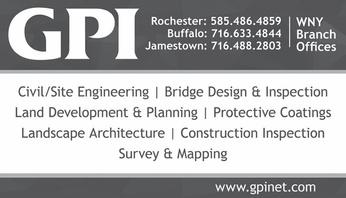



RIT will train graduate students for interdisciplinary research in essential semiconductor technologies
By Michelle Cometa, Sr News Specialist at Rochester Institute of Technology

JingZhang,associateprofessorinRIT’sKateGleasonCollegeofEngineering,willbeamongthefacultyresearchersmentoringmaster’sanddoctoralstudentsinsemiconductortechnologiesthroughanewNSFgrant.
RochesterInstituteofTechnologywillprovide20doctoralstudentfellowshipstoadvanceresearchinthemuch-needed fieldofsemiconductortechnologies.
TheNationalScienceFoundationawardedRITnearly$3millioninfundingfor“ConvergentGraduateResearchTraining inCMOS+XSemiconductorTechnologies”TheawardispartoftheNSF’sResearchTraineeshipProgram(NRT),a nationalinitiativetobetterpreparemaster’sanddoctoralstudentsfortheinterdisciplinarytalentsrequiredin semiconductorchipdevelopment.Italsoisameanstoaligntrainingwithevolvingworkforcedemandsandaddressa domesticsemiconductortalentshortage.
RIThassignificantexpertiseinmicroelectronicengineeringandCMOS,orcomplementarymetal-oxidesemiconductortechnologies,oneofthekeydevelopmenttechnologiestobuildandmanufacturesemiconductorchips.
Trainingopportunitieswillfocusonnext-generationCMOS+X(X=AI,biomedical,chemical,optoelectronic,photonic, nanoelectronic,quantum,andpackaging)technologies toaddressskillgapsinadvancedmaterialsanddevices, characterizations,packaging,modelingandsimulation,andsemiconductormanufacturingprocessesandfabrications, saidJingZhang,theprincipalinvestigatorandprojectlead.
“Ourprogramwillbeoneofthefirsttoofferatransformativeanddedicatedgraduateeducationtrainingmodelwith strongtechnical,professional,andDEI diversity,equityandinclusion components Weexpecttopreparemorethan 170next-generationsemiconductorengineersandscientiststohelpclosetheworkforcegapandtostrengthenthe nation’ssemiconductortechnologyleadership,”saidZhang,theKateGleasonassociateprofessorin

By Michelle Cometa, Sr News Specialist at Rochester Institute of Technology
theDepartmentofElectricalandMicroelectronicEngineeringinRIT’sKateGleasonCollegeofEngineering.Asan expertinoptoelectronicandnanoelectronicdevices,shehasbeenakeyresearcherinadvancingwidebandgap semiconductorsforultravioletandvisibleLEDs,lasersandverticaltransistors.
Overthefiveyearsoftheproject,programleaderswillworkwithstudentstoadvanceresearchinfourtracks:material innovation,micro-andnanoelectronics,optoelectronicsandphotonics,andintegratedcircuits,systems,andpackaging. Thesefocusareashaveextensiveandwide-rangingapplicationsofsemiconductorCMOS+Xtechnologiesinartificial intelligence,vehicleelectrification,andhigh-performanceandquantumcomputing,forexample.
“ThisisgamechangingforourPh.D.programsthathaveresearchaspectsin semiconductortechnology,sinceitwillallowustorecruittop-levelgraduatestudents byofferingthemthesefellowshipopportunities,”saidSethHubbard,oneofthe program’sco-PI’s.HeisdirectoroftheNanoPowerResearchLaboratories,teaches inthemicrosystemsengineeringdoctoralprogram,andleadsthenewphysicsPh.D. program,basedintheCollegeofScience.“Ibelievethiswillprovidestronggrowthin ourprograms,bothintermsofstudentsbutalsofaculty.
TheNRTprogramaddressesworkforcedevelopment,emphasizingbroad participation,andinstitutionalcapacity-buildingneedsingraduateeducationthrough strategiccollaborationswiththeindustry,non-governmentalorganizations, governmentagencies,nationallaboratories,andacademia
ZhangandHubbardwillbejoinedasprojectleadersbyengineeringandscience faculty-researchersStefanPreble,KarlHirschman,ParsianMohseni,KeXu, SantoshKurinec,IvanPuchades,andTejasviDas.Theywillmentorstudentsfrom theuniversity’smaster’sanddoctoralprogramsinRIT’sKateGleasonCollegeof Engineering,theCollegeofScience,theGolisanoInstituteforSustainabilityand theNationalTechnicalInstitutefortheDeaf

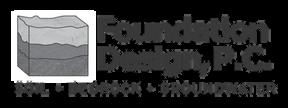
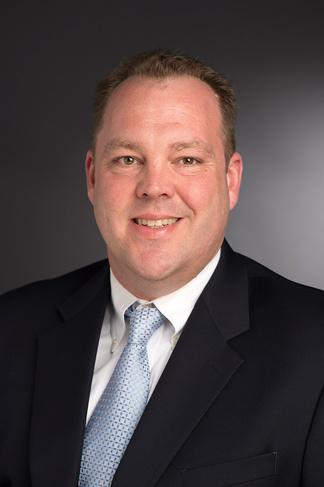


Crunelle has highest overall GPA across four years by Vienna McGrain
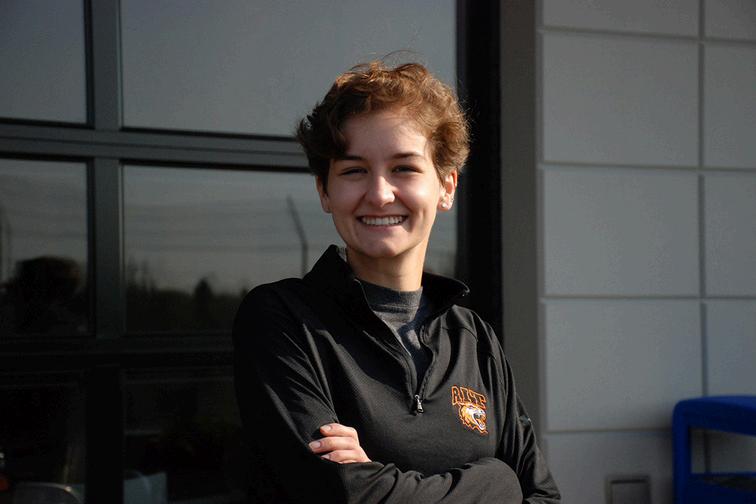
RITstudentJolieCrunelleisactiveinheracademicandextracurricularendeavors Asaresult,shehasbeenhonoredwiththeNormanA MilesAwardforAcademicExcellenceinStudyandwillberecognizedattheFallConvocationforNewStudentsonAug.22.
ForRITstudentJolieCrunelle,findingafacultymentortoexploreresearchwithandconfideinhashelpedherbecome successfulinandoutoftheclassroom.Basedonthisoutstandingblendofacademicandextracurricularpursuits,Crunelleis beinghonoredwiththe2024-2025NormanA.MilesAwardforAcademicExcellenceinStudy.
Theawardisgiventoanindividualwhobegantheirstudiesasafirst-yearstudentatRITandisenteringtheirfinalyearof undergraduatestudywiththehighestgradepointaverageacrosstheuniversity.Recommendationsfromdeansarealso considered Crunelle,whoisearningherbachelor’sdegreeinbiomedicalengineeringandamaster’sdegreeinscience,technology andpublicpolicy,withaminorinwomen’sandgenderstudies,wassurprisedtolearnthatshewontheaward.
“IhadnoideathatIwasevenincontentionforthisaward.Afterall,therearesomanyexcellentstudentsatRIT,”shesaid. “But,afterIlearnedmore,Iunderstoodthatthechairofmydepartment,aswellasmanyothers,reallywenttobatforme. I’msogratefulthattheywentoutoftheirwaytosubmittheapplicationonmybehalf"
OneofthosefacultyadvocateswasKristofferWhitney,associateprofessorintheDepartmentofScience,Technology, andSociety.Whitneybecameavaluableresearchmentor,includingCrunelleinhisworkstudyingthebiomedicaluseof horseshoecrabbloodtodetecttoxinsinvaccinesandmedicaltools.Healsohelpedfacilitateaco-writtenwhitepaperas wellasanarticleinTheConversationonthesubject.

Crunelle has highest overall GPA across four years by Vienna
McGrain
“ItallstartedwithanRITnewsstorythatIreadaboutDr.Whitney’sresearchandIjustaskedhimifIcouldbepartofhis researchteam,”saidCrunelle,whoisfromCharleston,S.C.“That’sthepowerofbuildingpartnershipsatRIT.” WhitneywasthrilledwhenhelearnedthatCrunellewouldbetheNormanMilesawardrecipient.
“It’sobviousthatJolieisanambitious,talented,andbrilliantstudent,”hesaid “But,themostimpressivethingaboutJolieto me,andwhyitisajoytoworkwithher,isthatshehascultivatedadeepintellectualcuriositythatallowshertodotruly interdisciplinarywork.”
Inadditiontoon-campuslearning,Crunellehasstudiedabroadonseveraloccasionsincludingfaculty-ledtripstoIrelandand Guatemala.Mostrecently,shecompletedatripwithEngineeringWorldHealth’sSummerInstituteinUgandawhereshe learnedaboutmedicaldevicetroubleshootingandrepairandworkedinaUgandanhospital.Whitneyhelpedheracquire fundingfortheexperience
CrunelleisalsoamemberoftheRITrowingteam,HotWheelzsolarracingteam,severalreligiousorganizationsoncampus, andVisVivaDanceCompany.
Aspartoftheaward,CrunelleandWhitneywilleachreceive$12,622.Crunellewillapplythefundstotuition;Whitneywilluse themoneyforprofessionalusesuchaspurchasingequipment,attendingconferences,orotherprofessionaldevelopment activities
“Ican’tstressenoughtheimportanceoffindingsomeonewhowantstohelpyouthrive,”shesaid.“Myadviceforincoming studentsistofindthatpersonwhoyoucanbrainstormideaswithovercoffee.Youjustneverknowhowthosepeoplearegoing toendupsupportingyou.”

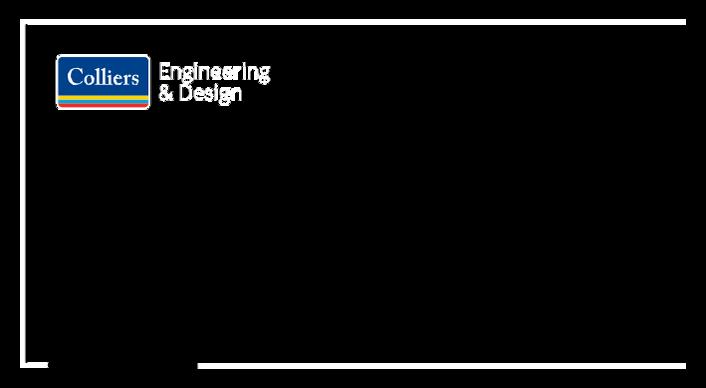
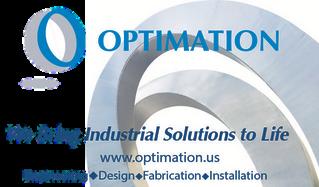
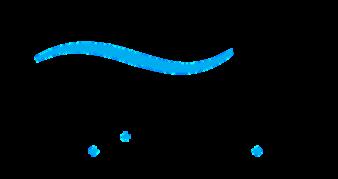

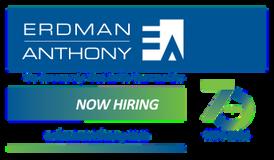

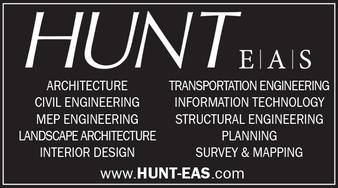

By Daniel Rodriguez, Site/Civil CAD Technician
Sean Phelan, Associate AIA.
HUNT’s High Falls office.

Daniel Rodriguez, the article’s co-author and a High Falls-ba the same energy he brings to his solar, wastewater, and K-12 efforts, as well as a willingness to entertain the questions we had about American Sign Language (ASL). Specifically, we wanted to explore ASL’s viability and future in the face of the increasingly sophisticated, translation software available now available for the Deaf on phones, computers, and networks
But first, what he really wanted to talk about was how to become a better engineer and more fully utilize the Engineering BS degree he had received from RIT in 2022.
A Site/Civil engineer charged with developing design site plans on HUNT’s clients’ behalf, Daniel is a New York City native married to Andrea, a Coloradoan who remotely works for the Washington, DC-based, Federal Deposit Insurance Corporation (FDIC) from their Henrietta home office.
Both Daniel and Andrea have been deaf since birth, and while they communicate entirely in sign language at home, we drafted this article together with a combination of pen-to-paper and Daniel and Andrea’s ASL exchanges and phone translation software outside Lovin Cup Cafe on a rainy summer day.

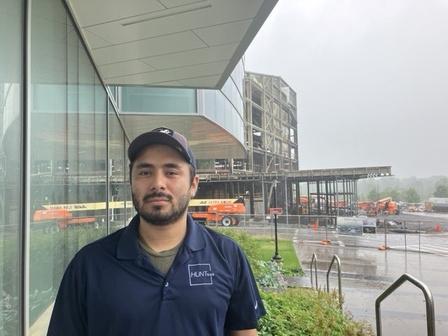
Daniel and his site design engineer and inspector colleagues spend a large part of the working week in the field assisting HUNT clients (including most recently Rochester’s Charlotte High School) with construction and stormwater permitting efforts prompted by land development projects.
For example, “to protect and safeguard the general health, safety, and welfare of the public residing within its watersheds”, the City of Rochester has established a “set of water quality and quantity policies to provide reasonable guidance for the regulation of stormwater runoff and safeguard persons, protect property, prevent environmental damage….and comply with the NYSDEC state pollutant discharge elimination system (SPDES) general permit for stormwater discharges…for the purpose of protecting local water resources from degradation”.
It is within that setting and with those goals that Daniel and his High Falls colleagues regularly operate
The engineering world thrives on clear and efficient communication, and phone translation technology, particularly speech-to-text conversion, is significantly improving communication accessibility for deaf engineers.
For his part, Daniel urges the use of call-in numbers at all meetings They allow him to use VRS Video Relay Service (VRS) to connect the meetings and interpret everything that is said in the meeting. VRS services are further enhanced by Video Remote Interpreter (VRI) software. VRS allows him to use ASL which VRI can interpret on a camera and internet as text on the screen (essentially subtitling Daniel’s input)
According to Daniel, beyond the difficulty of learning and incorporating CAD software into his daily skillset, his “most obvious work challenge is choosing the appropriate communication method”.
“Most of the time I use phone speech-to-text. Still, in the best-case scenario, I would prefer to use an ASL interpreter for any communication because interpreters can translate fully and clearly in 10 minutes what it still takes phone translation software about an hour”
“It’s important to remember that ASL is a completely different language from English, so it takes time to translate terms and phrases at the accuracy level I need for the job.”
In HUNT’s office, Daniel’s ability to shorten his learning curve and fulfill his professional demands has been dramatically accelerated by his relationship with Dillon Taylor, EIT, another HUNT Site/Civil Engineer and friend. Dillon’s son Jacob is Deaf, and consequently Dillon has become “well-versed” in ASL, although he insisted we make clear that his skills were “functional not fluent.” (Click on the attached YouTube video.)
Daniel and Dillon’s collegial interactions are further improved by having their desks side-by-side.
At the same time, Daniel is sensitive to overtaxing Dillon and thinks that the presumption by others that Dillon can act as interpreter limits their willingness to approach him directly He attributes his arguably more robust interactions with colleagues at other HUNT offices to both their unawareness of Dillon’s availability and a genuine desire to aid his successes.
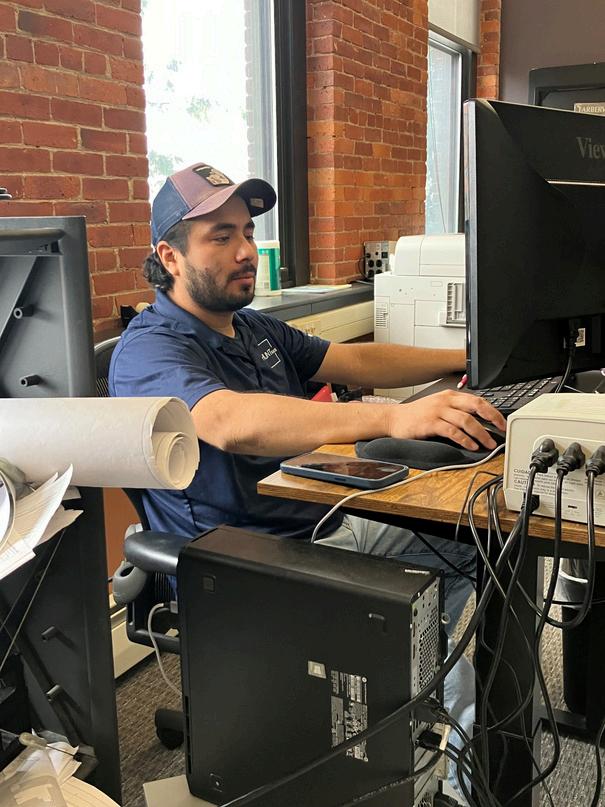
It took us several months to embarrassedly realize that we had positioned Daniel’s desk poorly, aiming him toward a screen that placed his back to an aisle and colleagues moving about the office At one point he quietly resorted to using a mirror to improve his ties to coworkers.
HUNT’s Office Manager Kym Finkle sought to address these obstacles recently by repositioning Daniel’s desk so he both looks directly out at coworkers in a heavily trafficked hallway and has a clear view-line to Dillon. Kym coordinates HUNT’s on-boarding process and developed an ASL tutorial schedule that welcomed all Rochester office personnel to get a sense of Daniel’s communication style and needs.
Specific advantages of digital translation platforms include increased independence and access to information
Deaf engineers can directly conduct phone conversations without relying sign language interpreters. This empowers them to manage appointments, handle client and colleagues’ project inquiries, and make calls independently. Realtime text transcription allows deaf individuals to follow phone conversations and participate actively in various settings like meetings, classrooms, and public service calls.
This active participation is particularly important to engineers as technical discussions often involve complex terminology and rapid back-and-forth. Phone translation software allows Deaf engineers to follow conversations in realtime, ask clarifying questions on the spot, and contribute their expertise effectively. This speeds up problem-solving processes and ensures they are fully on board with project developments.
As noted earlier, for Daniel and other young engineers the software has increased his confidence and independence. He doesn’t need to rely on Dillon and other colleagues to schedule calls or interpret conversations. This newfound independence empowers him to take ownership of communication and actively manage his professional interactions
Outside of the office the “accessibility on the go” nature of the translation tools is heightened by their increasing mobilefriendliness. Thus, allowing Daniel to take calls and participate in discussions while on-site or traveling for work. This flexibility ensures he can remain connected and informed, regardless of their location.
Translation Tools as a Supplement not an ASL Replacement
A profound and reoccurring theme in the conversations surrounding this article was the importance of the Deaf culture in and of itself, and inherently the ASL language. A core aspect of Deaf identity and community, Daniel and others underlined that sign language is not just a means of communication; it is a vibrant cultural expression.
They concurred with assertions that the focus “should be on improving accessibility features like captioned phones and video calling options, ensuring deaf individuals can use phones with their preferred mode of communication. Translation tools should be supplementary, not a replacement for established methods like sign language interpreters and relay services.”
Consequently, while advancements in phone translation technology offer a glimmer of hope for independent phone use by the Deaf community, it is crucial to acknowledge that these tools come with limitations that shouldn't sideline other established communication methods.
According to researchers, current shortfalls and concerns included the following: 1) accuracy -speech recognition technology is imperfect, especially with accents, background noise, or rapid speech. Misinterpretations during phone conversations can lead to misunderstandings and frustration for deaf users; 2) loss of nuance - phone translation tools primarily focus on converting words, failing to capture the subtleties of spoken communication like tone, sarcasm, or humor This can lead to missed messages and a transactional feel to conversations; 3) limited sign language integration - while some tools aim for sign language output, the technology is still nascent.
Current options might not encompass the full breadth and complexity of sign language, hindering clear communication; and 4) privacy issues - speech recognition often relies on cloud-based processing, raising privacy concerns for sensitive conversations. Deaf users might be apprehensive about their conversations being stored or accessed by third parties.
For his part, Daniel expressed a reluctance to utilize the stillfledgling AI tools, asserting further that Google Glasses-type devices are still a way off, and arguing that AI still probably does not catch all sentences and often misses the meaning of words. Human interpreters can still explain words and meanings much more clearly in sign language ”The current products – both AI and devices -- fail to catch the variety of expressions, ‘hand accents,’ and gestures that a human interpreter would,”, Daniel asserted.
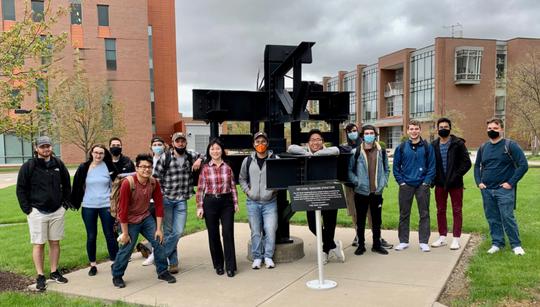
Moreover, for a professional engineer AI solutions often rely on cloud-based processing, raising concerns about the privacy of sensitive conversations and the potential for data breaches. Let alone, the simple ‘pleasures’ of human interactions that we naturally take for granted, i.e., AI translation still struggles with sarcasm, humor, and cultural references, leading to a loss of the richness and depth inherent in human communication.
While phone translation software isn't a perfect solution for Deaf engineers, its benefits are undeniable. By removing communication barriers, it empowers Daniel and others to excel in their fields, fostering a more inclusive and dynamic engineering environment.
Overall, phone translation technology is a significant advancement towards a more equitable and accessible communication landscape for the deaf community. Thankfully, advancements in phone translation software are transforming how Daniel navigates the professional landscape.
Wikipedia : AmericanSignLanguage(ASL)is anatural language[4]that serves as the predominantsign languageofdeaf communitiesin the United States and most ofAnglophone Canada. ASL is a complete and organizedvisual languagethat is expressed by employing both manual andnonmanual features.[5]Besides North America, dialects of ASL and ASLbasedcreolesare used in many countries around the world, including much ofWest Africaand parts ofSoutheast Asia ASL is also widely learned as asecond language, serving as alingua franca ASL is most closely related toFrench Sign Language(LSF) It has been proposed that ASL is a creole language of LSF, although ASL shows features atypical of creole languages, such asagglutinative morphology
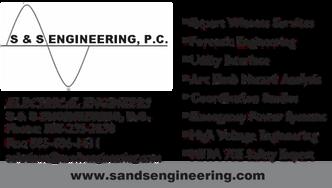


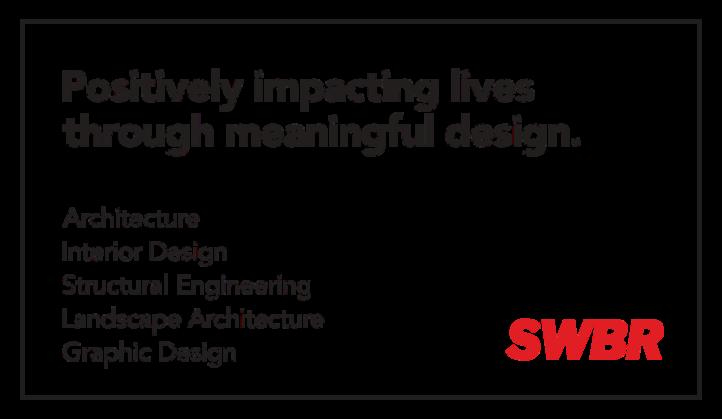




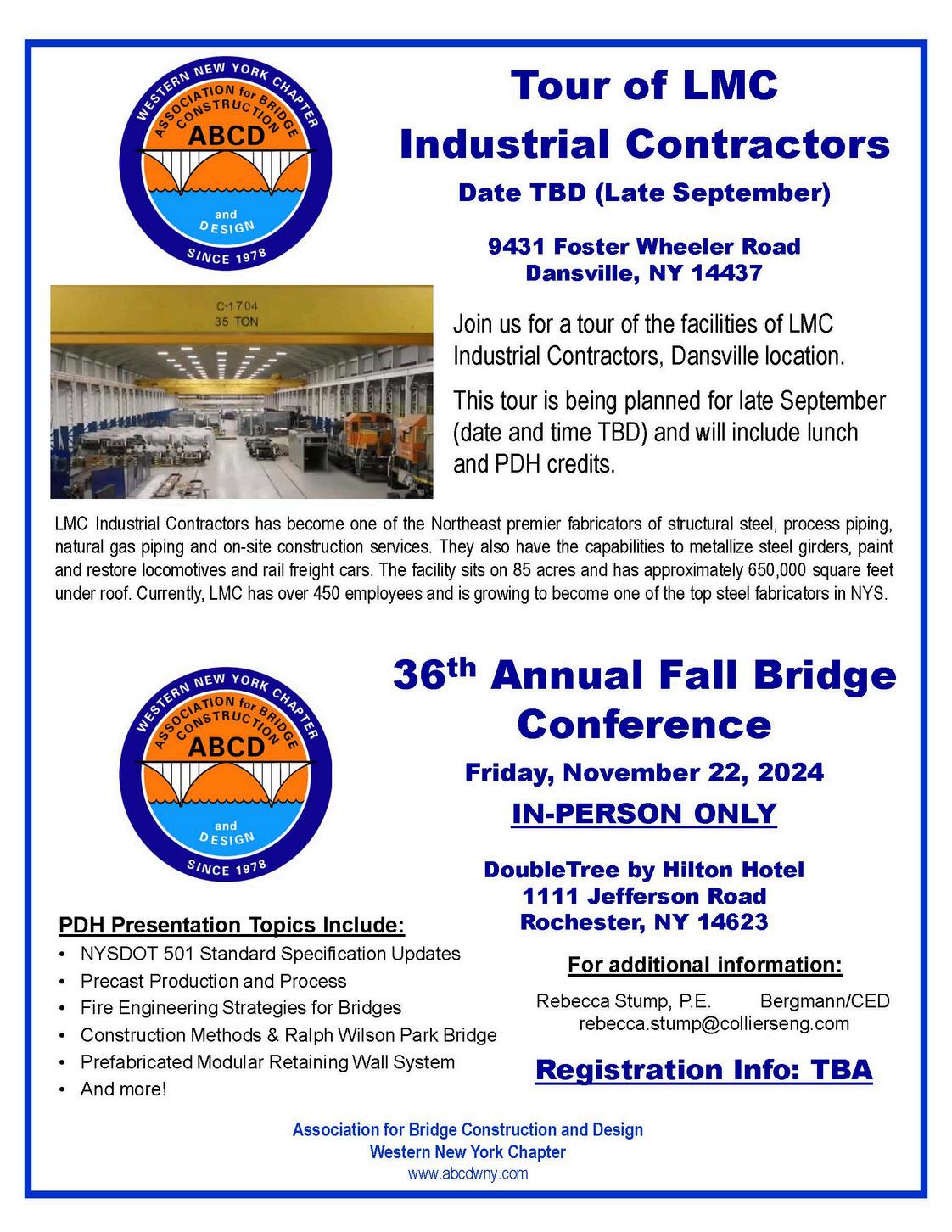

As we enjoy the tail end of summer, our Chapter is diligently working to prepare for our upcoming year. Mark your calendar and register now for our Fall Social BBQ event, which will be held on Thursday, September 12th at the Genesee Valley Park Roundhouse Pavilion. This will be a joint event hosted by both ASHRAE Rochester and Rochester Plant Engineers. Registration for this event is now open, and sponsorship opportunities are also available! We encourage the entire Rochester engineering community to join us at this event for a fun night out with friends and industry colleagues!
Jim Parks (Past President, 2023-24) and I recently traveled to Albany to represent our Chapter as the Delegate and Alternate at the ASHRAE Region 1 Chapter Regional Conference (CRC), held Thursday August 15th through Saturday August 17th. At this annual event, we attended business meetings and technical training sessions with Region1 leaders and Chapter leadership from the other fifteen (15) Chapters which form Region 1. The conference was a great opportunity to learn more about how other Chapters in our Region operate and brainstorm ideas to improve our Chapters.
Looking ahead to October, we will begin our monthly technical program series. Gannon Dubay is working to schedule our technical program for the year. If you have any speaker/topic suggestions for this year’s program, he can be reached at gannon.dubay@trane.com. Stay tuned for updates; Visit our website at www.rochesterashrae.org for future event information, a list of our current Officers and Committee members, to read our current Chapter newsletter, and more!
We are still searching for additional volunteers to fill committee roles for our Chapter. Please reach out to me or anyone on our board if you’re curious about getting more involved or have any questions regarding ASHRAE. I look forward to having a great year!
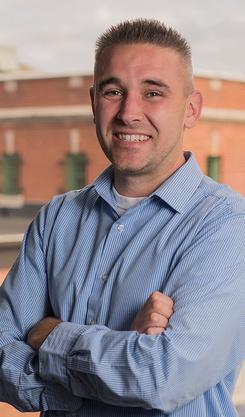
Bret Fryover ASHRAE Rochester Chapter President, 2024-25

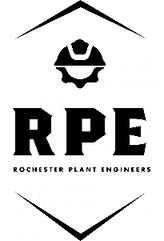

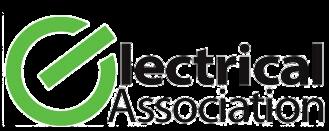
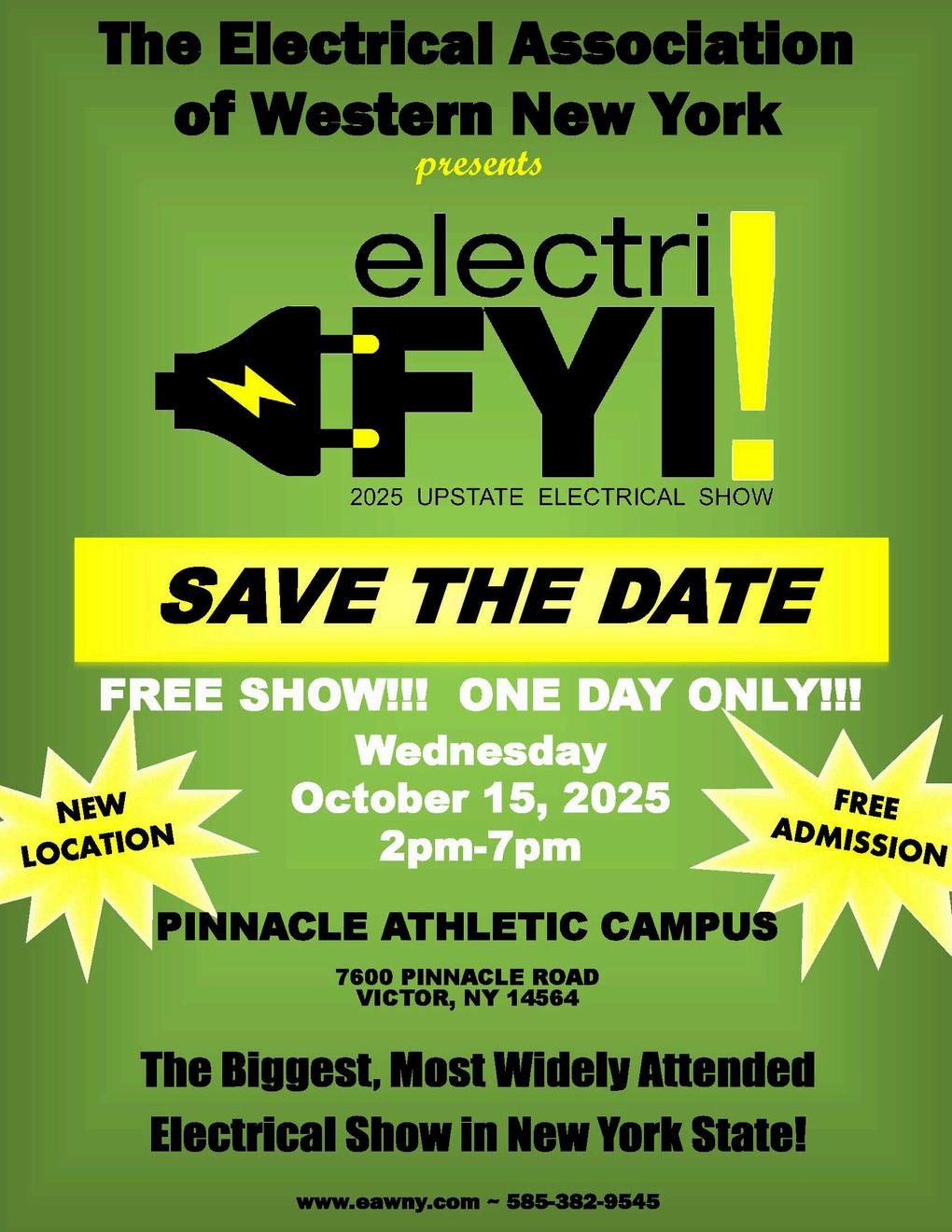


Officers & Societies
CHAIR
Kelly Robinson
VICE-CHAIR
Emmett Ientilucci
TREASURER
Lyle Tague
SECRETARY
Eric Zeise
AES & COMSOC
Cristiano Tapparello
CS & CIS
Bo Yuan
EDS & CSS
Sean Rommel EMBS
Cristian Linte GRSS
Emmett Ientilucci LIFE
Jean Kendrick
APS & MTTS
Danielle Walters PHOTONICS
Parsian K Mohseni
PES & IAS
Kelly Robinson
Jean Kendrick SPS
Eric Zeise
TEMS
Paul Lee
YOUNG PROF.
Eric Brown
STUDENT CHAP.
Univ. of Rochester
Ming-Lun Lee
RIT
Jamison Heard
AWARDS
Jean Kendrick COMMUNICATION
Christine Frayda
Howard Bussey
NEWSLETTER
Mark Schrader
PACE
Bruce Rubin
HISTORIAN
Ram Dhurjaty
CS/CIS
RES LIASON
Greg Gdowski
Dear Colleagues,
Our IEEE Rochester Section Executive Committee (ExCom) meets monthly to plan events. Our next ExCom meeting will be on Tuesday, October 1st, from 12:00 PM to 1:30 pm. Please feel free to register for in-person or virtual attendance at our next ExCom meeting using this link: (https://events.vtools.ieee.org/m/427166).
Our IEEE Rochester Section is active and has planned several key events. Participating in an IEEE event allows you to learn new, interesting things. And your attendance supports our vibrant Rochester technical community This is one of the many ways you can help elevate the practice of engineering in Rochester and enrich the experience of your engineering colleagues. Help us plan an event that you would find interesting. I look forward to working with you!

Regards,
Kelly Robinson, PE, PhD Chair, IEEE Rochester Section
2024 Western New York Image and Signal Processing Workshop (WNYISPW) Friday, November 8 at RIT
WNYISPW is a premiere venue for promoting research involving AI, image, and signal processing applications in the Western New York region and facilitating interaction between academic researchers, industry professionals, and students
The workshop is organized as a morning session, a Poster session, a catered lunch, and an afternoon session It will be held at the RIT Student Development Center on Friday, November 8th, 2024, from 8:00 AM (check-in) to 5:30 PM in a hybrid in-person and virtual format.
For details, including submission dates and available awards, see the workshop webpage at: https://ewh ieee org/r1/rochester/sp/WNYISPW2024 html For Questions and Paper Submissions, e-mail WNYISPW@gmail.com
Vanteon Wireless Solutions and theCenter for Emerging and Innovative Sciencesat the University of Rochester support WNYISPW, which the IEEE Rochester Section and the Rochester Chapter of the Society for Imaging Sciences and Technology sponsor.
WIE - Industry-Academia Engagement: A Next-Gen View, October 1, 2024, at RIT
WIE – Event, University of Rochester, October 8, 2024, starting at 11 AM.
Please look in vTools for more information: https://events.vtools.ieee.org/

CHAIR
Kelly Robinson
VICE-CHAIR
Emmett Ientilucci
TREASURER
Lyle Tague
SECRETARY
Eric Zeise
AES & COMSOC
Cristiano Tapparello
CS & CIS
Bo Yuan
EDS & CSS
Sean Rommel EMBS
Cristian Linte GRSS
Emmett Ientilucci
LIFE
Jean Kendrick
APS & MTTS
Danielle Walters PHOTONICS
Parsian K Mohseni
PES & IAS
Kelly Robinson
Jean Kendrick SPS
Eric Zeise
TEMS
Paul Lee
YOUNG PROF.
Eric Brown
STUDENT CHAP.
Univ. of Rochester
Ming-Lun Lee RIT
Jamison Heard
AWARDS
Jean Kendrick COMMUNICATION
Christine Frayda
Howard Bussey
NEWSLETTER
Mark Schrader
PACE
Bruce Rubin
HISTORIAN
Ram Dhurjaty
CS/CIS
RES LIASON
Greg Gdowski
Hosted by the Rochester IEEE Joint Chapters on Communications and Aerospace, the Second IEEE Upstate NY Workshop on Secure and Sustainable Communications Networks (SSCN) will be held on October 15th, 2024, from 9:00 AM to 5:00 PM in the B. Thomas Golisano Auditorium at the Rochester Institute of Technology
Participation Opportunities:
Oral Presentations and Posters:Submissions are invited for oral presentations of extended abstracts (maximum 2 pages) and poster presentations (½ page abstract).
Exhibitions:Companies are encouraged to exhibit their products or services at the workshop. Contact Dr. Nirmala Shenoy (nxsvks@rit.edu) or Garret Arcoraci (garret.arcoraci@rit.edu) as soon as possible
Sponsorship:Companies will be formally, officially acknowledged, and recognized for workshop sponsorship.
For more details on sponsorships, exhibitions, and submissions, please get in touch with Dr. Nirmala Shenoy at (585) 475-4887 or via email atnxsvks@rit.edu
Important Dates and Submission Links:
Paper Submission Deadline: September 1, 2024 (11:00 PM PDT)
Submit Papers Here (Posters:Submit Posters Here). For paper and poster submissions, please use the IEEE template availablehere. (Final Extended Abstract Submission: October 5, 2024)
On Friday, September 27th, RIT will host the (NNN) Symposium to connect NYS undergraduate and graduate students with our NYS industry partners to learn about and discuss "Growing the Semiconductor Workforce." The day will include a morning session with students, government, and industry talks, an afternoon poster session, and a career fair!
This event coincides with the IEEE EDS Activities in Western New York Conference:
STUDENTS: Plan to submit a nano-research-related abstract by August 21st to be part of this showcase for New York State students
https://www.cnf.cornell.edu/events/nys_nano/2024/abstracts
COMPANIES: Participate in the career fair or be a sponsor. https://www.cnf.cornell.edu/events/nys_nano/2024/sponsorships
More info at: https://events.vtools.ieee.org/m/427651


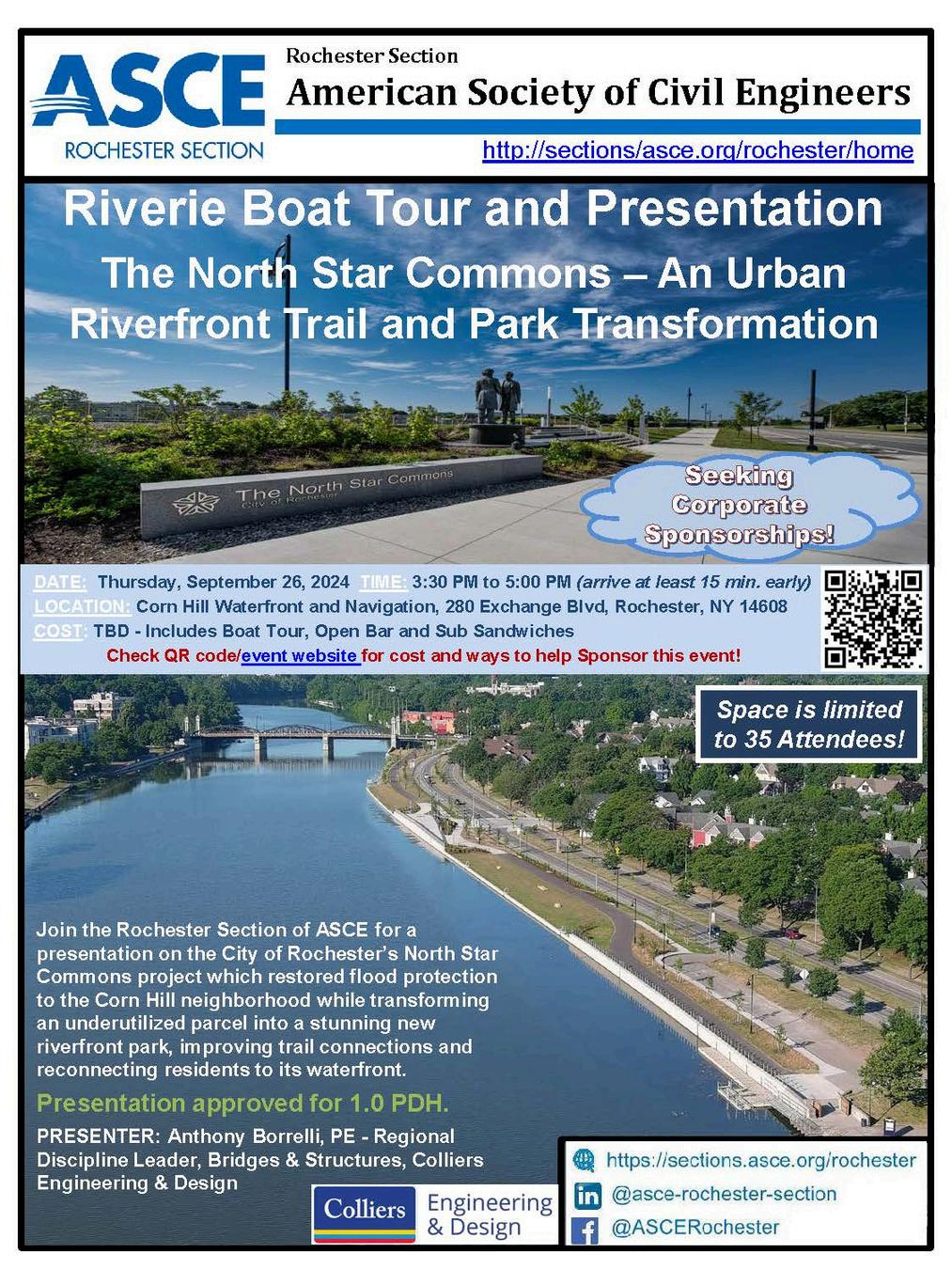

Wed. Sept. 18, 2024 at 6:00pm
Location: Hybrid meeting. Both in person and on-line
In-person: RIT Wallace Memorial Library – Room: Cary Graphic Arts Collection (Left at top of one flight up from entrance)
RIT campus – One Lomb Memorial Dr.
On-line (Zoom): https://us02web.zoom.us/j/88002780831
Meeting ID: 880 0278 0831
Abstract / Bio:
Roger Easton received the Ph.D. degree in Optical Sciences from the University of Arizona in 1986, and has been on the faculty of the Chester F. Carlson Center for Imaging Science at RIT nearly since its inception. Since the mid-1990s, his primary research effort has been the application of modern imaging technologies for recovering faded and/or erased writings from historical objects. Among the projects are the Archimedes Palimpsest (consisting of erased and overwritten copies of writings by Archimedes as well as other authors), palimpsests in the collection of St. Catherine’s Monastery in Sinai, the Dexippus and Herodian palimpsests at the National Library of Austria, the 1491 world map by Henricus Martellus Germanus at Yale, palimpsested writings at the Biblioteca Capitolare in Verona (newly identified as by the second-century author Apuleius), and a palimpsest with pages newly identified as the star catalog by Hipparchus. This presentation will describe the use of multispectral imaging for historical artifacts. For those attending in person, there will be a demonstration of a small MISHA system following the presentation.
IS&T Rochester Chapter Election Ballot
President, Bruce Pilman
Secretary, Wayne Prentice
V.P. Membership / Treasurer, Matt Ochs
V.P. Programs / Director, Roger Triplett
Councilor, Peter Burns

SWBR is proud to announce the addition of several new team members

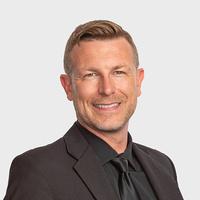


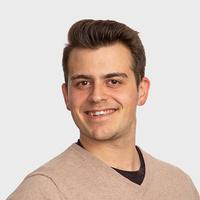

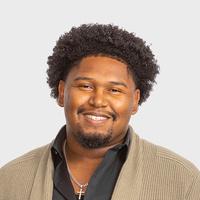
Brandon Colaprete joins SWBR as Senior Technical Coordinator.
Colaprete is responsible for project design and construction documents for higher education and K12 projects. He graduated from Pratt Institute with a Bachelor of Architecture.
Project Architect Cameron Cunneyworth manages all project phases from conceptual design to construction documents and construction administration on higher education and K12 projects. He received his Bachelor of Architecture from Syracuse University.
Structural Designer AJ Niles is responsible for the design, inspection, and/or evaluation of structural and load bearing components on a variety of project types. He earned his Bachelor of Science in Civil Engineering from the University at Buffalo.
Landscape Designer Joseph Perez assists with construction drawings and renderings on a variety of project types. He has a Bachelor of Landscape Architecture from SUNY College of Environmental Science and Forestry.
Interior Designer Leeann Perkowski is responsible for conceptual design, space planning, schematics, and furniture and material selections on a variety of project types She earned her Bachelor of Fine Arts in Interior Design and an Immersion in Communications from Rochester institute of Technology.
Project Designer Kyle Taylor is responsible for producing renderings, architectural drawings using BIM software, and laser scanning on a variety of science, technology, manufacturing, and commercial projects. He earned his Bachelor of Architecture from Alfred State College.

American Consulting Engineering, Companies of New York

American Public Works Association Monroe County/Genesee Valley Branch

American Society of Civil Engineers, Rochester Section

American Society of Heating, Refrigerating, and Air-Conditioning Engineers, Rochester Chapter

American Society of Mechanical Engineers, Rochester Section

American Society of Plumbing Engineers, Rochester NY Chapter
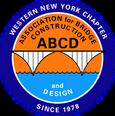
Association for Bridge Construction and Design

Electrical Association

Genesee Valley Land Surveyors Association


Monroe Professional Engineers Society
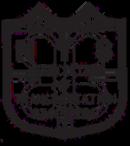
New York State Association of Transportation Engineers, Section 4

Illuminating Engineering Society of North America Inc., Rochester Section Rochester Plant Engineers

Imaging Science & Technology, Rochester Chapter


Sheet Metal & Air-Conditioning Contractor’s National Association Rochester, Inc

Institute of Electrical and Electronics Engineers, Rochester Section Society of Plastics Engineers, Rochester Section

Institute of Industrial and Systems Engineers, Rochester Chapter

Terra Rochester Finger Lakes Science & Engineering Fair

